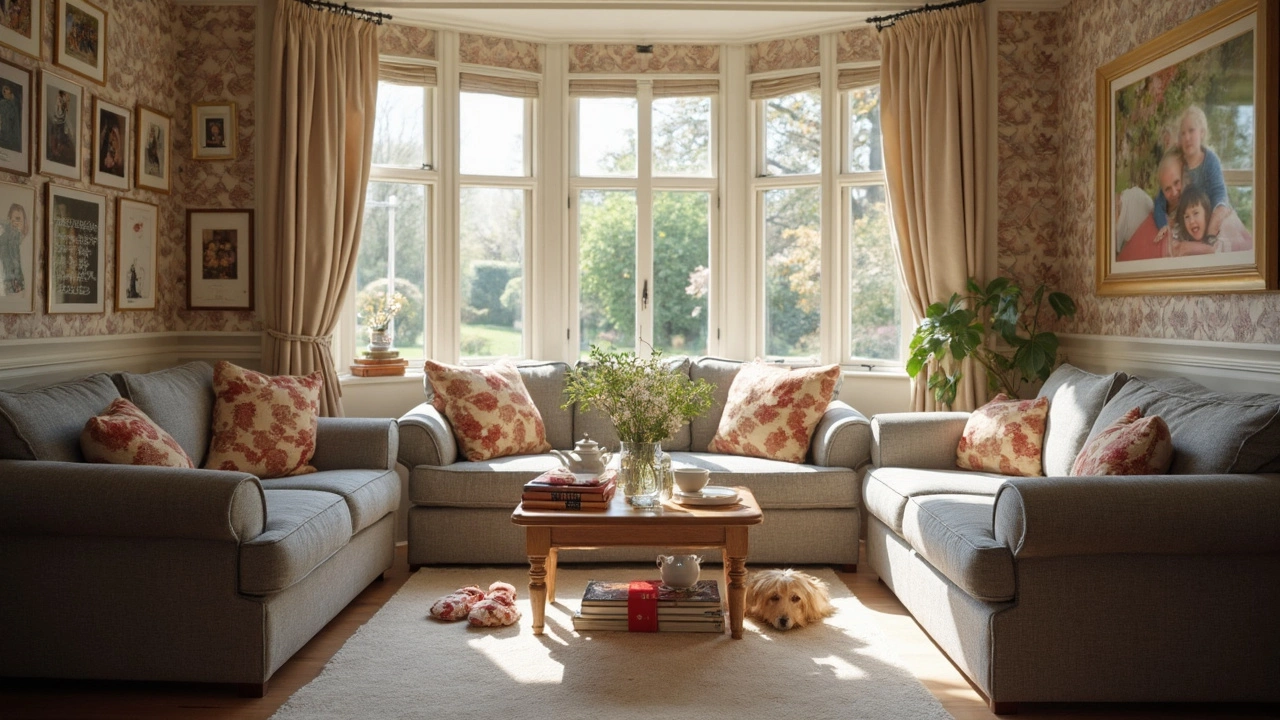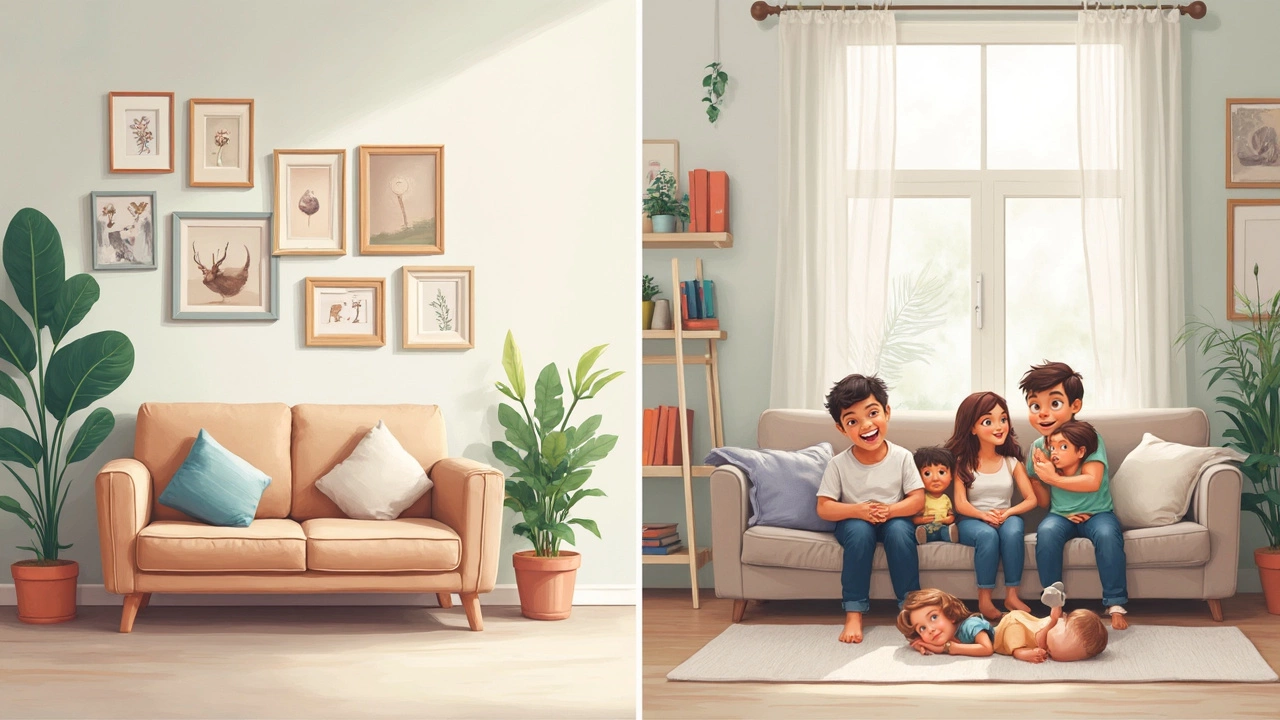Loveseat vs. Couch: Which One Actually Fits Your Life?

Picking between a loveseat and a couch sounds simple, but if you’ve actually tried to make your living room work, you know it’s sneaky hard. It’s not just about size—both bring a totally different vibe and set of practical pros and cons. Not all spaces welcome a massive couch, and not every bum fits happily on a loveseat for movie night.
Before you get stuck with something you regret, it makes sense to figure out if you really need that full-on sofa, or if a loveseat could pull off everything you want—and not hog the room. Let’s get real about what makes a loveseat totally worth it for some people and a terrible fit for others.
- What’s the Real Difference?
- When Space Is Tight
- Comfort and Social Life
- Style That Works for You
- Cleaning and Maintenance
- How to Decide: A Quick Guide
What’s the Real Difference?
Let’s get it straight: a loveseat is basically a small sofa built for two. A standard couch—or full-size sofa—is bigger, seating three or even four people. If you’re shopping, you’ll often see loveseats that measure between 48 and 72 inches wide, while couches usually start at around 78 inches and can go way past 90 inches for those huge sectionals. Here’s what these numbers look like side by side:
| Type | Typical Width (inches) | Seats |
|---|---|---|
| Loveseat | 48 - 72 | 2 |
| Couch/Sofa | 78 - 96+ | 3 to 4+ |
So the loveseat is the clear winner for saving space. But there’s more to it than width. Couches tend to have deeper seats and taller backs—so they’re the top pick for sprawling out or seating a group. Loveseats are lighter, usually easier to move, and can tuck neatly into a corner or create a separate zone in a bigger room.
Quick reality check: you won’t find anyone napping comfortably on a loveseat unless they curl up, yet dragging a couch into a tiny apartment or upstairs is close to mission impossible. Each has its job. Loveseats often get paired with larger sofas for more seating, but plenty of people mix and match them as the main piece, especially in smaller homes or city apartments.
Here’s a simple breakdown if you’re torn:
- Loveseat: Compact, ideal for pairs or small rooms, often cheaper, quicker to move or rearrange.
- Couch/Sofa: More seating, extra comfort, fits big families or people who love to lounge.
The bottom line: it’s not just about how they look—how you live, who visits, and your room size all matter when you’re picking sides in the loveseat vs. couch debate.
When Space Is Tight
Everyone wants their living room to be chill and comfortable, but if you’ve got a small apartment or an oddly shaped den, size matters. Here’s where the loveseat steps up. Most loveseats clock in at around 52-65 inches wide, while a standard couch is usually 72 inches or even longer. That can make a huge 2-3 feet difference in how you walk through the room or fit a coffee table that won’t stub your toe.
It’s not just about squeezing in furniture. Having less clutter on the floor means your space feels less cramped—and makes cleaning so much easier. Dragging out the vacuum is no fun when you’re bumping into everything. With a loveseat, you’ll probably have extra room for things like a small bookshelf, a work-from-home desk, or you know, just space to breathe.
If you’re trying to make a multifunction room—like a studio apartment or dorm—versatility is gold. Here are a few smart ways people use a loveseat in tight spaces:
- Pair it with an ottoman for a flexible setup you can move around easily.
- Fit it under a window to save valuable wall space for storage or TV stands.
- Mix it in with a couple of accent chairs so friends have places to sit but the room doesn’t feel like a furniture showroom.
Check the difference in sizes so you know exactly what fits:
| Furniture | Average Width | Seats |
|---|---|---|
| Loveseat | 52-65 in | 2 |
| Couch (Standard) | 72-90 in | 3-4 |
If your main goal is making your small living area work hard without feeling packed, a loveseat is almost always the winner. You’ll get the seating you need and enough room left over not to feel boxed in.
Comfort and Social Life
Let’s be honest, nobody buys seating for just how it looks—you want to be comfortable and make sure people aren’t awkwardly cramped or spread out. Here’s where the battle gets interesting.
If you’re comparing real-life use, a standard loveseat seats two, side-by-side. Great if you live alone or you and your partner like to sit close. But add a third person? Someone is perching on the arm or grabbing a chair from the kitchen. In contrast, a couch seats three or even four adults. That’s your best bet for movie nights, game day, or if your kids love to pile on with you.
- Loveseats tend to be about 52-72 inches wide. Couches usually run 75-88 inches or more.
- Cushion depth and back support are usually similar, but couches often feel more "sprawly"—you can spread out or nap comfortably.
- Loveseats work for small gatherings, intimate chats, or reading, but anything more and you might feel squeezed.
If you’re a regular host or have a big family, a loveseat on its own probably won’t cut it. But, it can be perfect for studio apartments, home offices, or bedrooms—where you might want cozy vibes and don’t need tons of space for people to crash. Want a social hub? Go couch. Want a private zone for two? Loveseat wins.
| Seating Option | Typical Width | Comfort Rating (1-5) | Best For |
|---|---|---|---|
| Loveseat | 52-72” | 4 (couples), 2 (groups) | Small spaces, couples, one-on-one hangouts |
| Couch | 75-88”+ | 5 (groups), 4 (solo) | Families, entertaining, napping |
Bottom line: Think about how you actually use your space. One size—or style—never fits all.

Style That Works for You
When it comes to home style, both loveseats and couches can do a lot, but they land very differently in your space. If you’re hoping for a classic look, a couch usually sets that up fast—it acts as a main anchor for the room. Loveseats, on the other hand, give you flexibility. You can move them around way easier or even use two across from each other for a cozy vibe that still feels open.
Design-wise, there’s no “best”—both options come in every type: modern and minimal, vintage tufted, super-plush, even those trendy modular styles that look great on TikTok. Here’s a quick breakdown of how they stack up for style and setup:
- Loveseat = easier for small rooms or apartments, doesn’t block windows or make a space feel crowded.
- Couch = feels traditional, especially for big gatherings or when you want max lounge area.
- Pairing a loveseat with a few chairs can give a living room more personality than just one long sofa.
- Both can be customized—fabric, color, arm style, and legs—but it’s easier to find bold, patterned options in loveseat sizes.
Worried about what really sells in stores or online? According to a 2024 sales report from a popular home retailer, 63% of couch buyers go for neutral grays and beiges, compared to 38% of loveseat buyers who pick something bolder, like blue or green.
| Furniture | Most Popular Color | % in Bold Colors |
|---|---|---|
| Loveseat | Blue | 38% |
| Couch | Gray | 17% |
If mixing and matching is your thing, the loveseat wins for flexibility. You can skip the predictable “sofa set” look and build a space that actually feels like you. But if you’re after that big classic setup, a couch will always deliver. The trick is to pick the piece that feels right for your style and your daily routine—not just what seems cool online.
Cleaning and Maintenance
If you worry about spills, crumbs, or pet hair, the difference between cleaning a loveseat and a couch is something you’ll definitely care about. Here’s the reality: loveseats are way easier to handle if you’re doing the cleaning yourself. Because they’re smaller, you can flip cushions, vacuum underneath, and get every corner in half the time it takes with a full-sized couch. Less surface means less hassle, and dragging a loveseat away from the wall is more of a one-person job.
With couches, you’re usually dealing with more cushions, more places where junk hides, and a heavier, awkward frame. Got a sectional? Multiply that effort. Steam cleaning, rotating cushions, and checking for loose change or lost remotes just takes longer. If your couch can’t be taken apart easily, deep-cleaning under or behind it can be, honestly, a pain.
Here are a few quick tips to make cleaning either one less annoying:
- Check the fabric tag before using any cleaners. Some fabrics only like water, not chemicals.
- Use a handheld vacuum or attachment for tight corners and under cushions.
- Pet owner? A lint roller or rubber glove can swipe up hair you didn’t know was there.
- Rotate and fluff cushions to spread out wear and stop lumps.
- If you eat on your sofa (we all do), wipe up food and drinks right away to avoid stains.
Regular upkeep keeps both loveseats and couches looking better for longer, but honestly, a loveseat just wins in the low-effort department. It’s all about less space, less work, and the same cozy feel if you choose right.
How to Decide: A Quick Guide
Still not sure whether to get a loveseat or a couch? You’re definitely not the only one. Here’s a down-to-earth way to make the call based on your own needs, space, and habits. This isn’t guesswork—use these real-life questions and some solid data to pick what works best in your home.
- Measure Your Room First. Grab a tape measure and check your floor space. The average loveseat is 52–66 inches long, while the standard couch runs 72–96 inches. If you’ve got less than 7 feet of wall, a loveseat’s probably the safer bet.
- Think About How Many People Need to Sit. If it’s just you or one other person most days, a loveseat is pretty cozy. Got frequent guests or a big family? You’ll want the extra seating of a couch.
- Look at How You Actually Lounge. Do you stretch out full-length or curl up? Fans of midday naps or movie marathons often find a couch more comfortable. Loveseats rarely let you sprawl out.
- Consider Moving or Rearranging. Loveseats are lighter—easy to move alone and they fit through tight doors or stairwells. If you rent or like mixing things up, this is a bigger deal than you might think.
- Compare Your Budget. On average, a loveseat costs about 20–30% less than a couch of similar quality and style. This can make a big difference if you’re watching your wallet.
Here’s a quick comparison table to see how they stack up side by side:
| Loveseat | Couch | |
|---|---|---|
| Average Length | 52–66 in | 72–96 in |
| Weight | 70–100 lbs | 100–150+ lbs |
| Seats | 2 | 3–4 |
| Starting Price (mid-range) | $400–$900 | $700–$1,500 |
| Popular For | Small apartments, bedrooms | Living rooms, families |
If you want something compact and easy to change around, a loveseat could be perfect. If you need room for more people or total comfort on those weekends at home, go for a full-size couch. Making the right call just means being real about your space—and your daily life.